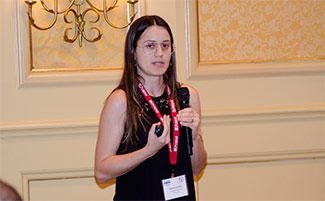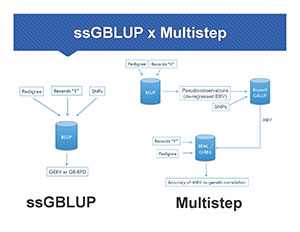New Way of Genetic Evaluation
American Angus Association and University of Georgia continue long-time research partnership to pursue methodology for genetic evaluation.
by Kasey Brown, associate editor
BILOXI, Miss. (June 11, 2015) — Genomics is kind of like a truck, explained Daniela Lourenco, postdoctoral associate at the University of Georgia, to attendees of the genetic prediction technical breakout session at the 2015 Beef Improvement Federation (BIF) Annual Convention in Biloxi, Miss., June 9-12.

Daniela Lourenco noted that trucks require fuel, oil and additives to run smoothly. In genomics, the genomic best linear unbiased prediction (GBLUP) equation requires data, pedigrees and genomic information.
In this analogy, she noted that trucks require fuel, oil and additives to run smoothly. In genomics, the genomic best linear unbiased prediction (GBLUP) equation requires data, pedigrees and genomic information.
Multistep GBLUP has been the most used form of genetic prediction. It requires several steps of inputting information throughout the process. However, Lourenco explained, single-step GBLUP (ssGBLUP) can input pedigrees, phenotypic records and SNPs in one step to produce estimated breeding values with genomic information or genomic-enhanced expected progeny differences (GE-EPDS).

While multistep required simple models, pseudo-phenotypes and genotyped animals, ssGBLUP uses the same models as in BLUP, with raw phenotypes, and both genotyped and ungenotyped animals, Lourenco explained. “The American Angus Association was a pioneer being the first to use multistep, and they are the first to use single-step with this amount of data.”
The American Angus Association has more than 8 million animals registered, but not all of them are genotyped. At the time of her research, about 82,000 were genotyped, and 70% of them were from animals born in or after 2012, she shared. Of these, 1,700 bulls had an accuracy greater than or equal to 0.85; 300 cows had an accuracy of greater than or equal to 0.85; and 31,000 had an accuracy less than 0.85. These animals were used as a reference population.
To help decide which animals should be genotyped, the researchers broke the reference population into three groups — ref_bulls: 1,700 top bulls with high accuracy; ref_2k: 2,000 top bulls and cows with high accuracy; and ref_33k, including all genotyped animals born from 1977 to 2012, totaling about 33,000. These reference groups were validated as to their ability to predict future phenotypes involving 18,721 animals born in 2013 for growth traits and 16,133 animals for calving ease.
Using ref_bulls increased predictivity relative to BLUP by 0.05 for birth weight (BW), 0.01 for weaning weight (WW), 0.04 for postweaning gain (PWG) and 0.01 for calving ease (CE). Including the ref_2k did not increase predictivity for any of the traits. Adding the ref_33k provided an additional increase in predictivity of 0.05 for BW, 0.03 for WW and 0.02 for PWG.
Since July 2014, the number of genotyped Angus animals has increased from 82,000 to 130,000 in June 2015. This large number of genotyped animals is nearing the 150,000 limit for regular inversion, yet Lourenco said that limitation has been overcome. By splitting the genotyped population into base and non-base animals, the ssGBLUP can still be applied. She noted that it doesn’t matter which animals are in the base population, as long as the base population is large. Ideally, the base population should include 10,000-15,000 animals.
Lourenco concluded that ssGBLUP is easy to implement by modifying relationship, and genomics improves evaluations. It can handle large populations of genotyped animals, and is flexible for interim evaluation on young animals.
The 2015 BIF Annual Convention was hosted by Mississippi State University and the Mississippi Extension Service June 9-12 at the Beau Rivage Casino and Hotel in Biloxi. The Angus Journal and LiveAuctions.tv provide comprehensive online coverage of the event at www.BIFconference.com. Visit the Newsroom for summaries, proceedings, PowerPoints and audio of the sessions; the Awards page for announcements of award winners; and the Photos page for photo galleries of the tour stops.
Editor’s Note: This summary was written under contract or by staff of the Angus Journal®. Through an agreement with the Beef Improvement Federation, we are encouraging reprinting of the articles to those who will adhere to the reprint guidelines available on this site. Please review those guidelines or contact Shauna Rose Hermel, editor, at 816-383-5270. PowerPoints are posted with permission of the presenter and may not be reproduced in whole or in part without the express permission of the presenter.
The Angus Journal's coverage of the event is made possible through collaboration with BIF and sponsorship of LiveAuctions.tv. For questions about this site, or to notify us of broken links, click here. Look for additional coverage in the Angus Journal, the Angus Beef Bulletin, the Angus Journal Daily, the Angus Beef Bulletin EXTRA and Angus TV.



